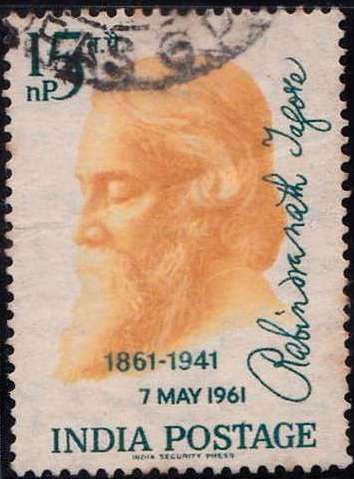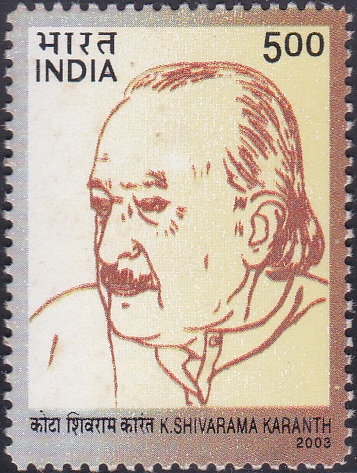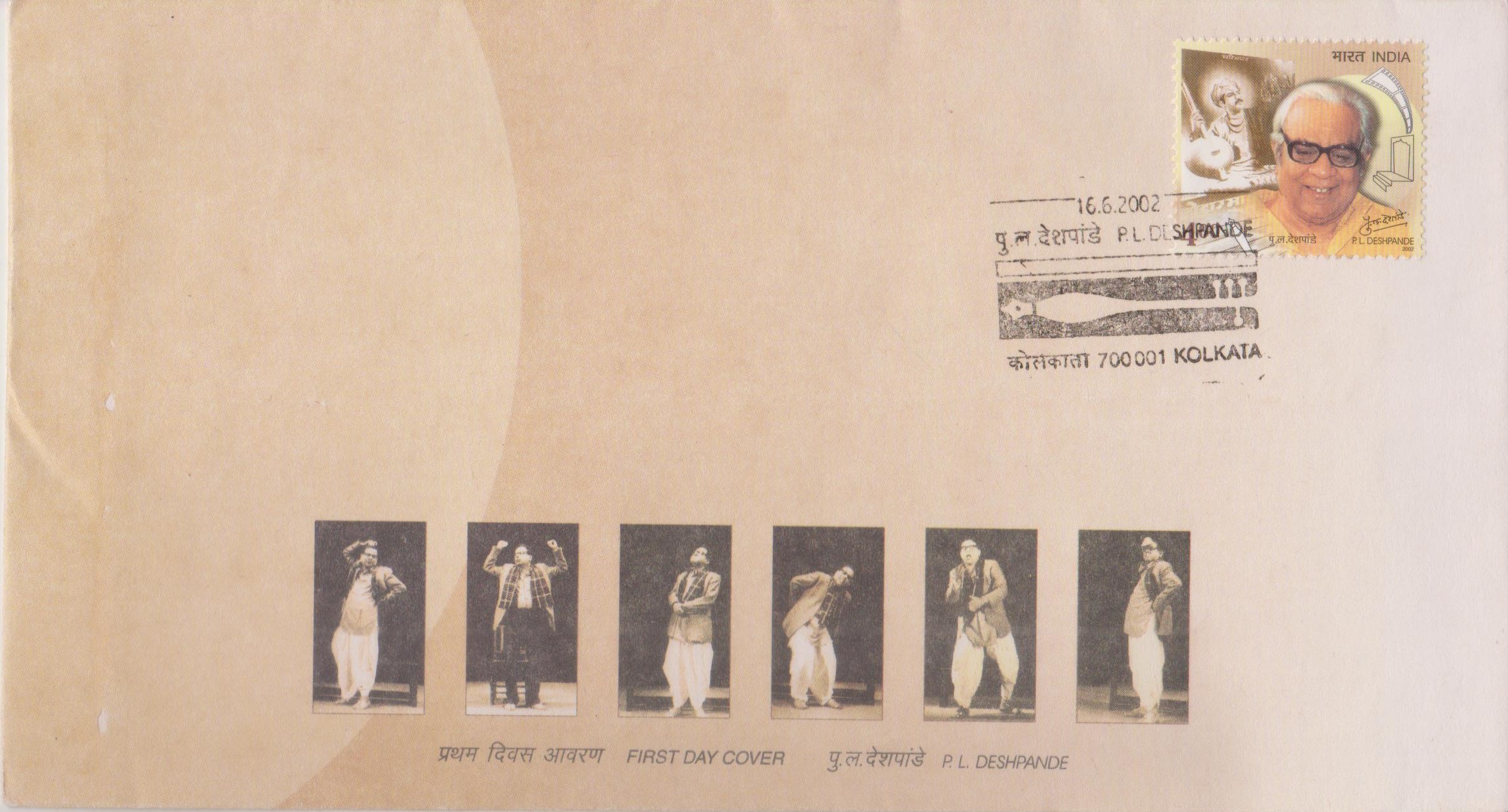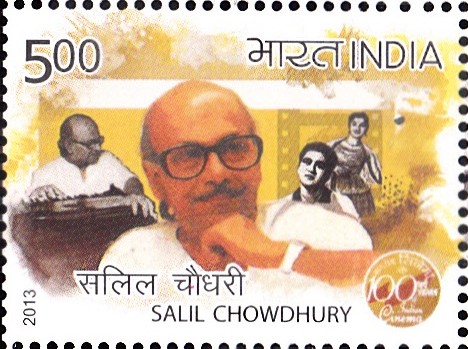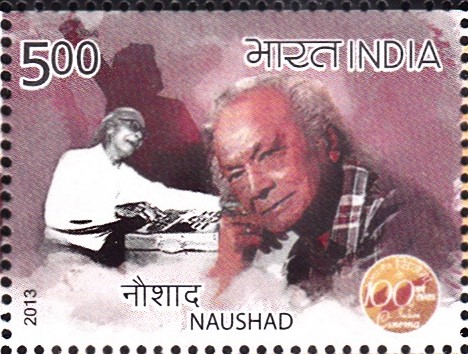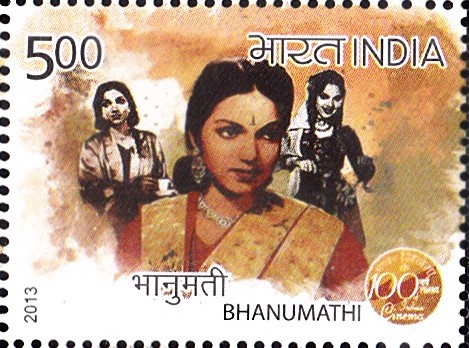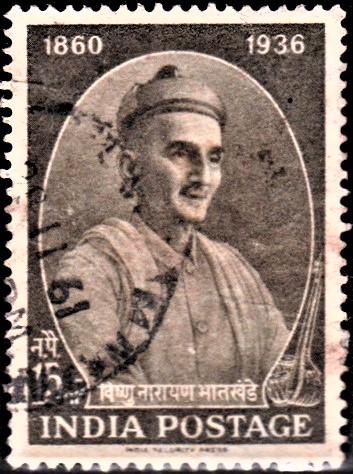
Vishnu Narayan Bhatkhande
A commemorative postage stamp on the 101st Birth Anniversary of Pandit V. N. Bhatkhande, an Indian musicologist, wrote 1st modern treatise on Hindustani classical music :
 Issued by India
Issued by India
Issued on Sep 1, 1961
Designed by : Staff Artists of the India Security Press
Type : Stamp, Postal Used
Colour : Raw Sienna
Denomination : 15 nP.
Size : 3.91 x 2.9 cms.
Perforation : 13
Watermark : All over multiple “Lion Capital of Asoka“
No. of stamps printed :2.5 million
Set : 35 stamps per issue sheet
Printing Process : Photogravure
Printed at : India Security Press, Nasik Rd.
Name : Vishnu Narayan Bhatkhande
Born on Aug 10, 1860 at Walkeshwar, South Mumbai, India
Died on Sep 19, 1936 at Bombay, India
About :
- The great architect of the renaissance Hindustani music, Vishnu Narayan Bhatkhande (1860-1936) belongs to a period of Indian history which saw a new and great awakening in all spheres of life. It was a period that saw the end of mere imitation of the Western modes on the one hand and mere revivalism on the other – a period of re-affirmation of all that was best in the past of India and readjustment of the past to new realities.
- Bhatkhande was born on the day of the Janmashtami festival (August 10, 1860). His birth anniversary is traditionally celebrated on Janmashtami Day which, this year, falls on September 1. Hence the choice of this date for the issue of a special 15 nP. postage stamp by the Posts and Telegraphs Department to pay homage to a man who put modern Hindustani music on a new path of constructive development. The special stamp marks the 101st anniversary of the birth of Bhatkhande.
- Educated at Elphinston College, Bombay, and Deccan College, Poona, Bhatkhande graduated in 1885 and joined the legal profession in 1887. After a spell of teaching at a high school, he practised law at the High Court where he earned a creditable name within a short time.
- His interest in music began during his college days when he started learning the sitar from Shri Vallabhdas. Within a few years he mastered the instrument sufficiently well. He joined the Gayan Uttejak Mandali, a well-known music circle in Bombay, and learnt vocal music under Raojibua, a Drupad singer. He also studied music with Mohd. Hussain Khan (younger brother of Inayat Hussain Khan) who was on the staff of the Mandali. His interest in music was not confined to learning the practice of it. He began to study the ancient texts such as “Bharat Natya Shashtra“, “Sangeet Ratnakar“, etc. Side by side, he took up the study of standard works on Western music.
- A fact which came to his notice was that music, as it was then practised, had very much changed, in its form, from what was described in the ancient texts. In fact he found that the definition of Shrutis and scales as given in ancient texts such as “Bharat Natya Shashtra“. “Sangeet Ratnakar” or “Parijat“ differed very much from the practice prevailing in the musical world of his time. He realised that there had been a great deal of transformation in the practical shape of music and a complete new systemisation and classification was necessary to put the existing musical system as prevalent in Hindustani music on a sound footing. The work was extremely difficult. There were hardly any musician left who had knowledge of theory or of ancient texts. Practicing musicians of those days were extremely reluctant even to demonstrate fully their own practical knowledge. They treated music rather as a “treasure”. With the rapidly disappearing patronage of the various princes, music had dwindled down to a few small centers and the number of authoritative and good musicians was sadly depleted. The task had also become more difficult on account of the conservatism of the musicians and their refusal to consider anything beyond their ken as something knowledgeable or according to the Shashtras.
- After the death of his wife and his daughter, Bhatkhande practically abandoned his legal practice and devoted the rest of his life to the aim of systemising the prevailing forms of Hindustani music and building on their basis a systematic and coordinated theory and practice of music. His main aim was to formulate a set of rules that would make knowledge of music accessible to all its lovers. He organised many music conferences, in order to bring about an agreement regarding the prevailing standards and forms of music. For gaining a thorough knowledge of musical lore, he toured throughout India, visiting well-known libraries and private collections. He acquired from them ancient texts in Sanskrit, Hindi, Telugu, Tamil and other languages. He himself edited and published the more important among them. At the same time, he visited every musicians of note in the Hindustani music world and tried to get from him knowledge of prevailing practices. He spent quite some time in Gwalior, Baroda and Rampur, he collected some very important Dhrupads of Tansen from the Late Vazir Khan and the Late prince Sadat Ali Khan. His profound knowledge of music and keen ear enabled him to record the large number of standard compositions he had collected in correct notation in Swara and Tala for the first time. This missionary work was accomplished in the phase of enormous difficulties. Skillful diplomacy on his part enabled him to get together this unique collection from professionals who were extremely reluctant to part with their “treasure”. Equipping himself thus with a thorough knowledge of the ancient Shashtras and the present practice and forms of Hindustani music, he took up the task of systemising the whole. In doing this, he tried to coordinate the existing practical forms and based them on a rational theory which had its root in the ancient texts, but which, at the same time, did not try to read a meaning into them which did not exist. He frankly acknowledged where present practice differed from ancient ideas. His first publication was a small booklet called “Swar Mallika“ containing set compositions, describing all the ragas generally prevalent. The first of the series came out in 1907. In 1909, he published the Sanskrit text “Shri Mallakshaya Sangeetam“. This contained model compositions composed by him and describing known ragas. He also published at about this time his first book on “Hindustani Sangeet Paddhati“ which was an authoritative and detailed commentary of the prevailing raga music. The four volumes of this work are still the only standard treaties on Hindustani music, detailing all the practical ragas and explaining the Shashtric background. Bhatkhande realised that in order to spread music it was essential to have proper music schools and colleges teaching music in a rational and correct way. He took up this task in his systematic and energetic manner. In 1916, the reorganisation of Baroda State music school was completed under his guidance. With the active support of the Maharaj of Gwalior, he helped in the establishment of the Madhav Music College at Gwalior. Later, in 1926, the Morris College of Music was established in Lucknow under his guidance with the help of U. P. Government. He prepared detailed study courses for these institutions. Realising the necessity of reliable textbooks for the guidance of teachers and students, he prepared a series of standard textbooks well known as “Hindustani Sangeet Karmik Pustak Mallika“. These textbooks contain practically all the important prevailing ragas, give their basic theory and illustrate them with standard traditional compositions in notations. They are still the only standard and authoritative textbooks of Hindustani music.
- Having devoted all his life to the cause of music, he passed away on September 19, 1936. He was able to accomplish in his life-time the Herculean task of discovering and collecting ancient texts, investigating thoroughly the prevailing forms and compositions and ultimately systemising the whole so that the future development of Hindustani music could take place in a coordinate and systematic way. The task required a combination of diverging qualities which is difficult to find united in one person. Single-handed, he achieved what many scholars and musicians would have been able to carry out with great difficulty. The re-establishment of the important lace of music in society and its cultural life was a task which he successfully initiated. His achievements in the field are epoch-making. He gave a cohesion and brought order out of chaos in the world of Hindustani music, gave it a direction and set a pattern. The renaissance of Hindustani music and its rapid growth during the last few decades is greatly due to his guidance and inspiration.
- Works published by Pandit Bhatkhande :
- 1. Books written by him :
- His important works are :
- (i) “Shri Mal–Lakshya Sangeetam“ A treatise on the theory of Music in Sanskrit in slokas and describing the important ragas.
- (ii) “Lakshan Geet Sangrah“ in three parts. Compositions descriptive of the Ragas, giving their characteristics in songs. This is a practical corollary to “Lakshya Sangeetam“. These have been specially composed by Pandit Bhatkhande.
- (iii) “Hindustani Sangeet Paddhati“ in 4 parts. A commentary on the Lakshya Sangeetam in Marathi. It is a detailed study and discussion of the theory of music and explanation of 150 Ragas of Hindustani music. This important work has been translated into Hindi.
- (iv) “Kramik Pustak Malika“ This important book was published in six parts. It is a detailed textbook of Hindustani music, describing all the important Ragas, their theory and illustrated with well-known compositions in notations. It contains about 1,200 such compositions.
- Other books written by him are :
- (i) “Swara Malika“ (in Gujarati characters), notation of Ragas in swara and Tala.
- (ii) A comparative Study of the Music Systems of the 15th, 16th, 17th and 18th Centuries (in English).
- (iii) Historical Survey of the Music of India.
- (iv) “Geet Malika“ – which was originally published in 23 monthly issues, each containing 25 to 30 classical compositions of Hindustani Sangeet in notation.
- (v) “Abhinav Raga Manjari“ (in Sanskrit), a treatise on the Ragas of Hindustani music, each being described briefly in one sloka.
- (vi) “Abhinav Tala Manjari“, a textbook in Sanskrit on the Talas.
- His important works are :
- 2. Old manuscripts edited by him :
- (i) “Swara Mela Kalanidhi” by Ramamatya
- (ii) “Chaturdandi Prakashika“ by Venkatmakhi
- (iii) “Raga Lakshanam“
- (iv) “Raga Tarangini“ by Lochan
- (v) “Raga Tatva Vibodh“ by Shriniwas
- (vi) “Sadraga Chandrodaya“ by Pundarik Vithal
- (vii) “Raga Manjari“ by Pundarik Vithal
- (viii) “Raga Mala“ by Pundarik Vithal
- (ix) “Nartan Niranaya“ by Kashinath Shashtri Appa Tulsi
- (x) “Sangeet Sudhakar“ by Kashinath Shashtri Appa Tulsi
- (xi) “Sangeet Kalp Drumankur“ by Kashinath Shashtri Appa Tulsi
- (xii) “Raga Chandrika“ by Kashinath Shashtri Appa Tulsi
- (xiii) “Raga Chandrika Sar“ (Hindi).
- 1. Books written by him :
Subscribe
Login
0 Comments


